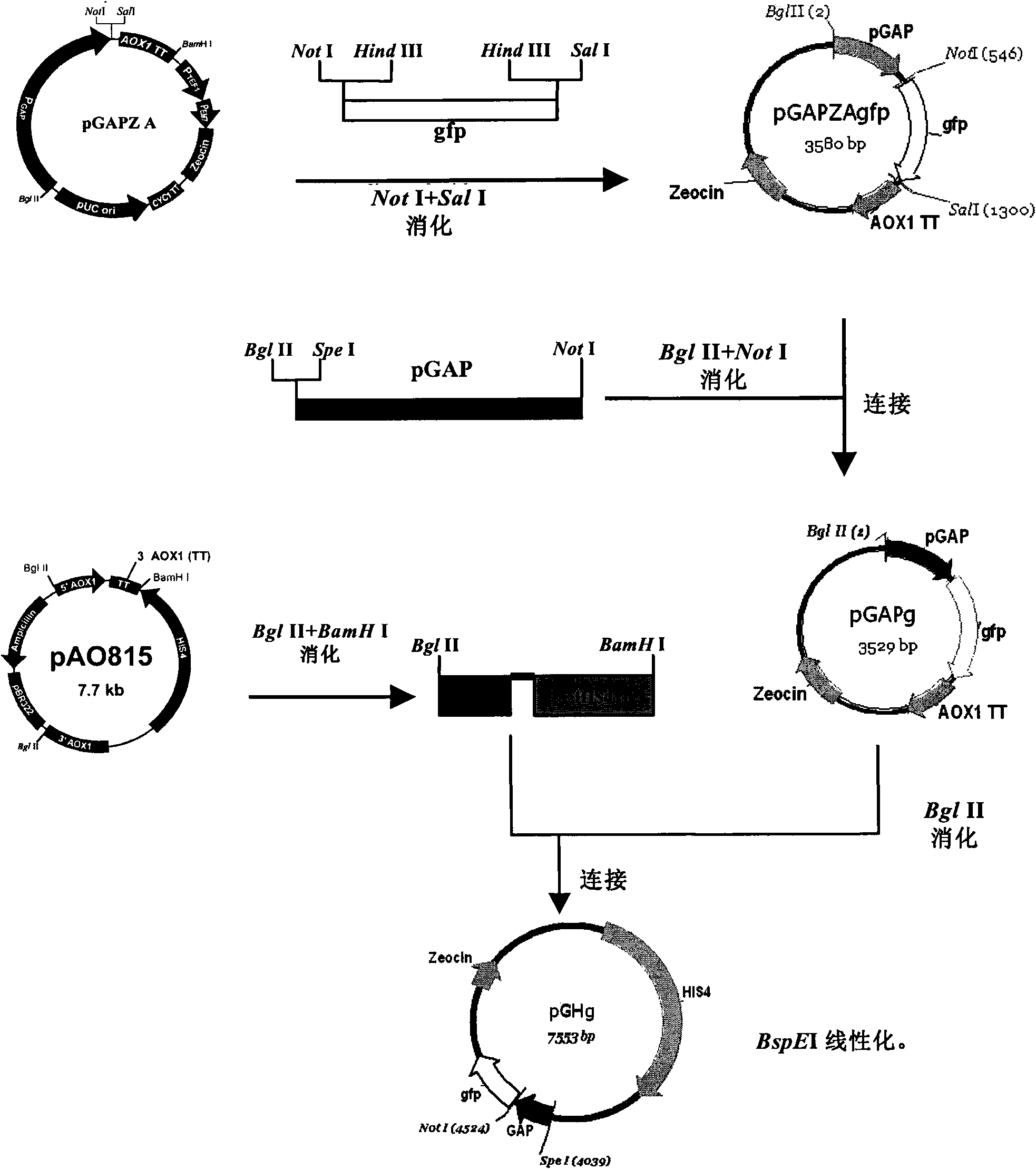GAP promoter library and application thereof
A technology of promoter and library, applied in the field of GAP promoter library of Pichia pastoris
- Summary
- Abstract
- Description
- Claims
- Application Information
AI Technical Summary
Problems solved by technology
Method used
Image
Examples
Embodiment 1
[0104] Embodiment 1, the construction of recombinant bacteria G / GHg
[0105] Green Fluorescent Protein (GFP) was used as a reporter gene to characterize the GAP promoter strength regulating its expression. In order to construct a reporter gene expression vector and facilitate the insertion of a mutant promoter, the original unmutated GAP promoter was first used to regulate the expression of the reporter gene gfp, and the GFP reporter gene expression vector pGHg and the corresponding recombinant strain G / GHg were constructed, and the The vector pGH containing the GFP gene and the recombinant strain G / GH were used as controls to investigate the expression of GFP.
[0106] 1. Construction and identification of expression vector pGHg
[0107] (1) Construction and identification of recombinant plasmid pGAPZAgfp
[0108] refer to figure 1 , using the chemically synthesized gfp gene (SEQ ID NO: 15) as a template, using the primer GFP F(AAT GCGGCCGC AAACCC AAGCTT ATGTCTAAAGGTGAAG...
Embodiment 2
[0123] Embodiment 2, the establishment of screening model
[0124] 1. Determination of screening medium
[0125] (1) Effects of different media on GFP fluorescence detection
[0126] PBS was used as a negative control to investigate the effects of different culture media on GFP fluorescence detection.
[0127] Sterile BMD, BMDY, YPD, BSM medium (see Invitrogen’s operating manual: A Manual of Methods for Expression of Recombinant Proteins in Pichia pastoris) and PBS were each added to a 96-well plate to measure the fluorescence intensity by a fluorescent microplate reader (excitation wavelength: 488nm, emission wavelength: 505nm). It was found that BSM medium had the least interference on the determination of fluorescence intensity (BSM: 537 (RFU); PBS: 460 (RFU)), followed by BMD: 616 (RFU). The fluorescence intensities of the sterile medium BMDY and YPD detected by a fluorescent microplate reader are 47581 (RFU) and 46499 (RFU) respectively, which are more than 100 times h...
Embodiment 3
[0165] Embodiment 3, the construction of GAP promoter mutation library
[0166] In order to construct a promoter library and obtain a mutant promoter with a wide range of promoter strength and a gradient change in promoter strength, it is necessary to obtain a promoter with abundant mutations and a method for quickly and efficiently screening mutants. Error-prone PCR (EP-PCR) is a simple and rapid method for making random mutations in a DNA sequence. The basic principle is that by changing the concentration of some components (such as dNTP and Mg 2+ Concentration), so that bases are randomly introduced to a certain extent to create sequence diversity. The key to error-prone PCR is to select an appropriate mutation frequency. Generally, the frequency of beneficial mutations is very low, and most mutations are harmful or neutral. When the mutation frequency is too high, it is almost impossible to screen beneficial mutations; when the mutation frequency is too low, the wild typ...
PUM
 Login to View More
Login to View More Abstract
Description
Claims
Application Information
 Login to View More
Login to View More - R&D
- Intellectual Property
- Life Sciences
- Materials
- Tech Scout
- Unparalleled Data Quality
- Higher Quality Content
- 60% Fewer Hallucinations
Browse by: Latest US Patents, China's latest patents, Technical Efficacy Thesaurus, Application Domain, Technology Topic, Popular Technical Reports.
© 2025 PatSnap. All rights reserved.Legal|Privacy policy|Modern Slavery Act Transparency Statement|Sitemap|About US| Contact US: help@patsnap.com



